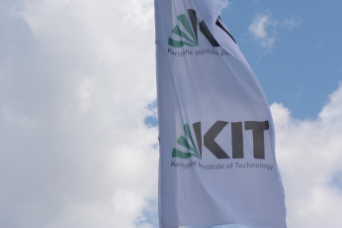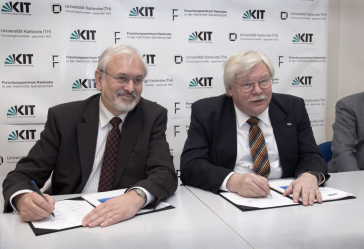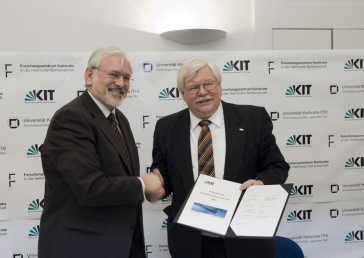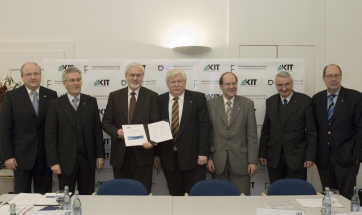|
Today, the Universität and the Forschungszentrum Karlsruhe signed the agreement on the foundation of the Karlsruhe Institute of Technology (KIT). This is the first milestone on the way to the complete merger envisaged by both partners. With effect from January 1, 2008, both partners will interlock their management and establish interdisciplinary KIT centers and KIT departments. They will use each other’s infrastructures, including the large-scale research equipment, and pursue a joint appointment policy. |
Dr. Elisabeth Zuber-Knost Kaiserstraße 12 |
|
“With KIT, two equal partners have created great prospects for the future. Both institutions are pursuing excellent science and have an outstanding reputation. But only with KIT do we reach the critical mass that will make us rank among the top institutions worldwide”, says the rector of the Universität Karlsruhe, Professor Horst Hippler. The concept for the future submitted under the excellence initiative about one year ago has now been put into practice by the signatures of both partners. “With the foundation of KIT, we assume a central pioneer role in research and education in Germany, and maybe even in Europe”, emphasizes Professor Eberhard Umbach, Chairman of the Executive Board of the Forschungszentrum Karlsruhe. “If we succeed as planned”, says Umbach, “the KIT will become an institution that will combine the advantages of a university that is strong in research with those of a multidisciplinary large-scale research center.” The agreement on the foundation of KIT will govern the process of joining of both partners until the declared objective will be reached: The merger. The merging of a university and a research center of the Helmholtz Association goes much further than the scientific cooperative ventures practiced so far. “If the German science system wishes to remain competitive on the international level, we are forced to enhance entirely new ways of cooperation between research institutions and universities”, states the Federal Minister of Research Annette Schavan. She underlines that KIT might well be a model for other German locations of science. With effect from January 01, 2008, the Universität or Campus South and the Forschungszentrum or Campus North will make a giant step towards each other in order to produce values added by KIT research, teaching, and innovation. The major novelties: The Forschungszentrum and the Universität Karlsruhe Will Unite Their Executive Boards The partners will establish joint management and decision making. With this, short decision making processes and rapid, consistent acting will be achieved. Joint Research by KIT Centers and KIT Focuses Helmholtz programs, research projects, collaborative research centers, and a DFG center will be combined in interdisciplinary KIT centers and KIT focuses. January 01, 2008, marks the start of the three KIT centers “Energy”, “Nano and Micro Scale Sciences”, and “Elementary Particle and Astroparticle Physics”. Shortly afterwards, the KIT focus “Networked Adaptive Systems” will be founded. Large Joint Competence Portfolio Its joint competence portfolio will provide KIT with a far larger basis of excellent scientists, engineers, and technicians, who will be active in six competence areas. KIT Departments for Research and Innovation From January 01, 2008, the Research Staff Division will support KIT scientists in their research projects and act as a contact partner for the funding of research. The Innovation Department (to be founded in 2008) will provide for the transfer of developments from research to industrial application, promote business ideas, and support the career service. In the future, scientists may work both at KIT and in industry. Joint Appointment Policy and Straight-Forward Appointment Procedures With this, KIT will be able to more rapidly respond to the needs of research and teaching and to win excellent scientists. Teaching at KIT - Benefits for Students Scientists of the Forschungszentrum will be involved in teaching. The student/teacher ratio and, hence, the support of the students will be improved. At the same time, students may take part in large-scale research projects of the Forschungszentrum. Helmholtz research projects will be integrated in university seminars. KIT School of Energy in 2008 The interdisciplinary KIT School of Energy will take up work next year. It will follow the model of the Karlsruhe School of Optics and Photonics (KSOP, from January 01, KIT School of Optics and Photonics). Karlsruhe House of Young Scientists (KHYS) und House of Competence (HoC) From April 01, 2008, KHYS will offer mentoring programs for pre-doctoral students and post-docs, provide support in the search for scholarships, convey key qualifications, and help with applications. KHYS will cooperate with the already opened House of Competence (HoC) that integrates multidisciplinary key competences in courses of study and develops advanced training programs. Joint Service Units The first joint KIT unit - Public Relations and Marketing Department (PKM) - has already been founded. In early 2008, the computing centers will be joined into the Steinbuch Centre for Computing (SCC). In late 2008, the libraries will merge. The Karlsruhe Institute of Technology (KIT) represents the merger of the Universität Karlsruhe with the Forschungszentrum Karlsruhe. Altogether, it has 8000 employees and an annual budget of 600 million Euros. The KIT will be an institution of internationally excellent research and teaching in natural and engineering sciences. KIT shall attract the best experts from all over the world, set new standards in teaching and promotion of young scientists, and establish the leading European center in the field of energy research. KIT will assume a leading role in nanosciences worldwide. It is the objective of KIT to be one of the most important cooperation partners of industry. | |
|
Photos for the Press
Prof. Umbach and Prof. Hippler sign the agreement
Prof. Umbach and Prof. Hippler
| |

Photo by: Universität Karlsruhe
lg, December 13, 2007
Contact:
Christian Könemann
Chief Press Officer
Phone: +49 721 608-41190
Fax: +49 721 608-43658
christian koenemann ∂does-not-exist.kit edu
The photo in the best quality available to us may be requested by
presse ∂does-not-exist.kit edu or phone: +49 721 608-41105.
presse ∂does-not-exist.kit edu or phone: +49 721 608-41105.



